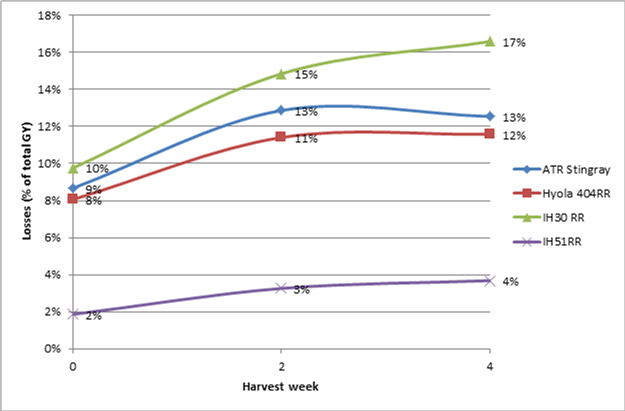Trial Details
| Property | Esperance Downs Research Station (EDRS) – Gibson, Paddock N14 |
| Agzone 6 | Growing Season rainfall (GSR, A-O) = 314mm, GSR + stored water (estimate) = 324mm. Thunderstorm dropped 44mm of rain in one day with associated strong winds on 14 November – three days prior to the second harvest. |
| Soil type | Fleming sand/duplex (1.4% organic carbon) |
| Paddock rotation | Wheat 2013, sub clover based pasture 2012, sub clover based pasture 2011 |
| Sowing date | 14 May |
| Fertiliser | 400kg/ha of gypsum (17% Ca, 14% S) topdressed over whole site before seeding, 102kg/ha of Agras No.1 at seeding (16%N, 9.1%P, 14.3%S, 0.06% Zn), 120kg/ha of Muriate of Potash and topdressed over whole site four weeks after seeding, 103kg/ha of urea (46% N) topdressed over whole site on 10 July; 1L/ha of Twin Zinc (70% Zn) 4 July; and 1L/ha Mantrac (50% Mn) 9 July; 70L/ha of UAN (32%N) 4 August. |
Treatment details
12 treatments:
Four cultivars - IH51 RR, IH30 RR, Hyola 404RR and ATR Stingray
Three harvest times - on time, two weeks later and four weeks later
Split plot design – main plots: times of harvest, sub-plots: varieties
Four replicates
Results

Conclusion
The Bayer podguard variety IH51 RR had lower losses at harvest than other varieties, averaging 3% losses at the latest harvest date compared to 10-14% for the other varieties. Most of the losses of all varieties occurred at harvest. Despite strong winds and rain prior to the second harvest, shedding before harvest was lower than expected, of the order of 15-70kg/ha (17-29% of total losses) with the majority of losses at harvest (approximately 70-400kg/ha). Interestingly the podguard variety did not shed seed out of the pod, but any losses prior to harvest were due to the occasional pod dropping off the plant.
The losses at harvest using the Department of Agriculture and Food, Western Australia (DAFWA) small plot harvester are likely to be larger than wider commercial machines (usually less than 150kg/ha). The reasons for this being we were going slow (3km/hr) to enable us to stop at the end of the plots, which resulted in the crop building up at the knife and the reel was consequently spending an appreciable amount of time beating the crop before it moved into the broad elevator. When our DAFWA harvester is moving more quickly this build-up is reduced. Nevertheless this trial showed the concept of the podguard trait does result in lower total losses.
However the variety IH51RR appears to be inherently lower yielding and lower oil producing than most other canola varieties. Consequently even with higher losses in other RR cultivars IH30RR and Hyola 404RR produced similar yields (approximately 2.8t/ha) and higher oil (46% compared to 43% for IH51RR). Therefore it would be interesting to see this non-GM trait in a better genetic background.
Acknowledgements
This trial is one of a series conducted throughout WA as part of the DAFWA and Grains Research and Development Corporation co-funded project 'Tactical Break Crop Agronomy in Western Australia' (DAW00277). Thanks to the Chris Matthews for excellent trial management. Pam Burgess (DAFWA Esperance) provided technical assistance to ensure all measurements occurred in a timely and accurate fashion.
Trial code: 14ED11
